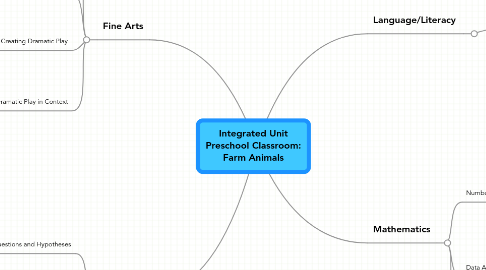
1. Fine Arts
1.1. Creating Art
1.1.1. Activity: Children paint barn yard scenes that incorporate all the animals they have learned.
1.2. Creating Movement and Music
1.2.1. Activity: Children dance along to "Animals on the Farm" acting like each particular animal and creating their own movements for how they think that animal would behave.
1.2.2. Activity: Children sing finger songs and nursery rhymes related to farm animals.
1.3. Creating Dramatic Play
1.3.1. Activity: Children act out the different stories relating to farms, e.g. Maisy on the Farm taking on the role of the animals.
1.4. Dramatic Play in Context
1.4.1. Activity: Using a barn doll house, farmers, farm animals, etc. children engage in imaginary play
1.4.2. Activity: Children are provided with props such as a cowboy hat, animal costumes, a hoe, etc. and then put on a play about what life on a farm is like.
2. Science
2.1. Observes, Questions and Hypotheses
2.1.1. Activity: children match the baby farm animal to the correct parent, i.e. a calf to a cow or a duckling to a duck.
2.2. Analysis and Conclusion
2.2.1. Activity: Children describe the differences between animals, such as bulls have horns while cows have utters.
2.3. Communication
2.3.1. Activity: Each child is assigned an animal to learn facts on then each presents their animal to the class.
3. Language/Literacy
3.1. Vocabulary Development
3.1.1. Activity: Read farm books
3.1.2. Activity: Sing "Old MacDonald" and other farm related songs
3.1.3. Activity: While playing with figurine farm animals, children practice the correct names and sounds of each.
4. Mathematics
4.1. Number Sense
4.1.1. Activity: Figurine/Pictures of farm animals are used for counting.
4.1.2. Activity: Children place correct number of horses/cows/chickens/etc. when given a written numeral.
4.1.3. Activity: Using the figurines, children determine if there are more cows than horses, etc.
4.2. Data Analysis
4.2.1. Activity: Children sort animals into their appropriate groups, i.e. pigs with pigs.
4.3. Patterns
4.3.1. Activity: Animals are arranged in patterns and children are asked to repeat the patterns. E.g. cow, duck, pig, cow, duck, pig.
